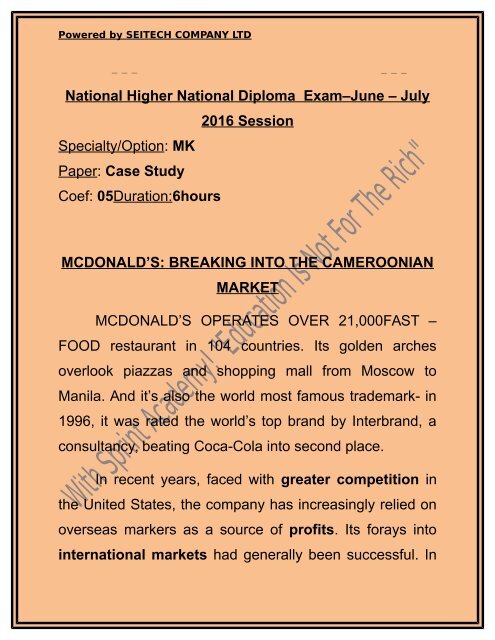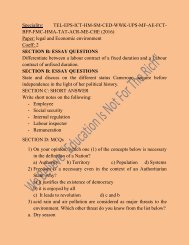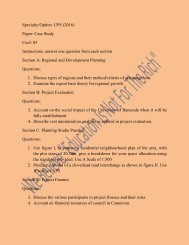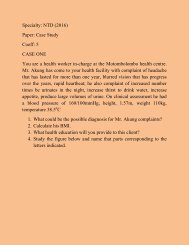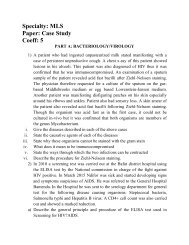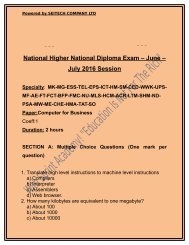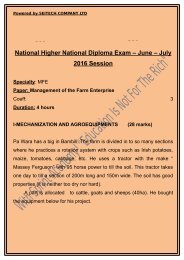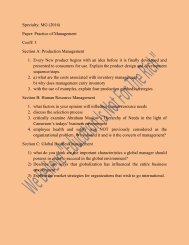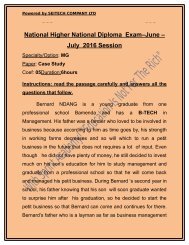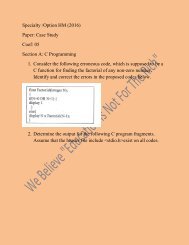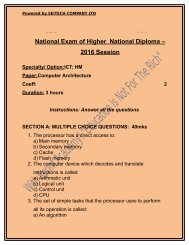MK(CASE STUDY)-min
You also want an ePaper? Increase the reach of your titles
YUMPU automatically turns print PDFs into web optimized ePapers that Google loves.
Powered by SEITECH COMPANY LTD<br />
National Higher National Diploma Exam–June – July<br />
2016 Session<br />
Specialty/Option: <strong>MK</strong><br />
Paper: Case Study<br />
Coef: 05Duration:6hours<br />
MCDONALD’S: BREAKING INTO THE CAMEROONIAN<br />
MARKET<br />
MCDONALD’S OPERATES OVER 21,000FAST –<br />
FOOD restaurant in 104 countries. Its golden arches<br />
overlook piazzas and shopping mall from Moscow to<br />
Manila. And it’s also the world most famous trademark- in<br />
1996, it was rated the world’s top brand by Interbrand, a<br />
consultancy, beating Coca-Cola into second place.<br />
In recent years, faced with greater competition in<br />
the United States, the company has increasingly relied on<br />
overseas markers as a source of profits. Its forays into<br />
international markets had generally been successful. In
Powered by SEITECH COMPANY LTD<br />
2045 as part of its overseas empire building, McDonald’s<br />
made its first venture into Cameroon. Like many American<br />
multinationals, McDonald’s had long its eye on the<br />
Cameroonian market, but waited until now. It however, has<br />
a registered world famous trade marker. McDonald has<br />
finally decided to press ahead with an investment in the<br />
Cameroon.<br />
However, by the time the first McDonald’s restaurant<br />
opened in 2015, it was clear to the American giant that it<br />
was entering a rather unusual market. For years, behind<br />
the shelter of sanctions and its own protective tariffs,<br />
Cameroon had spawned a first-world consumer industry.<br />
Some of its fast food companies had built up strong local<br />
brands specifically catering to Cameroon tastes.<br />
The company also discovered that s local trader had<br />
applied both to register the McDonalds’ trade marker for<br />
his own use, and to have the American company’s right to<br />
the trademark withdrawn (its trademark) registered had<br />
technically expired). McDonald’s instantly filed a case<br />
against the trader, and applied to register the trademark
Powered by SEITECH COMPANY LTD<br />
for itself. As one of the world’s leading brands, McDonald’s<br />
was plainly associated with the trademark around the<br />
globe and the company could reasonably expect the<br />
Cameroonian courts to protect it from lookalikes. Although<br />
its trademark registration had expired in the country,<br />
McDonald’s argued, under a clause in Cameroonian law,<br />
that ‘special circumstances’ had prevented it entering the<br />
market: namely, trade sanctions against, when the case<br />
came to the Supreme Court, in October 1995, things did<br />
not turn out quite the way McDonald’s had expected.<br />
Three cases, in fact were heard at the same time. Two<br />
were brought by Cameroonian traders, each of which<br />
already ran a fast-food restaurant under the name<br />
McDonald’s and each of which wanted to deprive<br />
McDonald’s of the right to trade under that name. The third<br />
case was brought by McDonald’s, which was suing the<br />
other companies for using and imitating its brand. The<br />
cases rested on two questions. One was whether<br />
McDonald’s was a ‘well-known mark’. If it was, then the<br />
company would be instantly entitled to protection from
Powered by SEITECH COMPANY LTD<br />
imitation by local traders, and the impostors would have to<br />
pack up shop. The second was whether McDonald’s claim<br />
of ‘special circumstances’ could be justifies.<br />
For McDonald’s managers the answer to the first<br />
question was self-evident. Though they recognized that<br />
Cameroon had a relatively sophisticated fast-food industry<br />
of its own, the idea that such a famous global brand might<br />
not be well known Cameroon seemed preposterous. Two<br />
market-research surveys conducted in Cameroon<br />
confirmed that the brand was indeed well known. The<br />
judge presiding I the Supreme Court case, however,<br />
argued that the surveys were conducted among the rich<br />
living Bonanjo, Bonamoussadi, and could “by no stretch of<br />
the imagination be regarded as representative of the entire<br />
Cameroonian population; 76percent of which is black. The<br />
judge threw McDonald’s case out. What of the second<br />
question, concerning the firm’s claim that ‘special<br />
circumstances’ had kept it out of the Cameroonian<br />
market? McDonald’s had first registered its trademark in<br />
Cameroon in 1965, and then renewed it at regular
Powered by SEITECH COMPANY LTD<br />
intervals until 2008. Under Cameroonian law as it stood at<br />
the time, a company lost its right to the trademark if it’<br />
languished unused on the books for five years, unless<br />
there was a good reason. Again, the judge did not believe<br />
that ‘special circumstances’-were the real reasons that<br />
McDonald’s had left its trademark unused for so long:<br />
‘there is no explanation for the failure to commence<br />
business in Cameroon, he declared, ‘other than the fact<br />
that Cameroon simply did not rank on McDonald’s list of<br />
priorities’.<br />
These legal setbacks were temporary. McDonald’s<br />
was allowed to press ahead with opening restaurants<br />
while it prepared its case for the Appeal Court. In last<br />
2015the American burger chain won this second battle:<br />
the Appeal Court. In essence, applied a less strict test of<br />
what it meant to be well known in Cameroon, and<br />
accepted the evidence in the two surveys because it<br />
thought that whites represented McDonald’s target<br />
markers. The case was a harbinger of the sort of trouble<br />
that McDonald’s was to experience throughout Cameroon.
Powered by SEITECH COMPANY LTD<br />
But McDonald’s had not given up easily. The firm<br />
continued to invest in opening new outlets after that. At the<br />
end, it operated 35 restaurants in the country- a small –fry,<br />
though, compared to the 227it runs in nearby NIGERIA. It<br />
has scored well against local rivals in slick service and a<br />
studied appeal to children. However, there are still worries<br />
that McDonald’s is treating its Cameroonian market as if<br />
chicken products as alternatives. Some of its local<br />
managers have expressed how odd the choice is given<br />
that the majority of local black consumers tend to favour<br />
chicken, which is cheaper than red m eat. White<br />
consumers, by contrast, tend to be beef-obsessed. They<br />
argue that ‘politically correct’ McDonald’s seems unwilling<br />
to acknowledge, in the overt way that its local rivals do,<br />
the point that the split between beef hamburgers and<br />
chicken has as much to do with race as with products,<br />
McDonald’s judged that the South African market was<br />
not different enough to merit product adaptation from<br />
the start. It would wait instead to see how the standard<br />
McDonald’s menu went down. McDonald’s experience in
Powered by SEITECH COMPANY LTD<br />
the market is a stark re<strong>min</strong>der of the challenges facing<br />
companies seeking to penetrate new country markets.<br />
Even the most powerful, established, global brands from<br />
developed countries can hit a number of unexpected<br />
barriers to entry in to a foreign market.<br />
Importantly, the company cannot expect to trample<br />
all before it in developing or e merging country market –<br />
particularly when local consumers can choose established<br />
local alternatives. If the owner of the world’s leading brand<br />
encounters such troubles, companies with a less wellknown<br />
trade mark must think twice before venturing into<br />
foreign markets. When deciding to take advantage of an<br />
international marketing opportunity, firms should consider<br />
a number of questions.<br />
QUESTIONS<br />
SECTION A: 40MARKS (8X5<strong>MK</strong>S)<br />
1. Briefly discuss four reasons why firms venture<br />
internationally. (1.25m k each)
Powered by SEITECH COMPANY LTD<br />
2. Give four risk a Global firm like McDonald’s can face<br />
in a country like Cameron (1.25mk each)<br />
3. Apart from product adaption as an international<br />
product and promotion strategy, what other four<br />
strategies are available in the category?<br />
4. Identify the approach used by McDonald’s to enter the<br />
Cameroonian market (2mks). Give two advantages<br />
on such an approach (1.5mk each)<br />
5. Apart from the approach mentioned in (4) above, what<br />
other two methods can be used to enter the foreign<br />
market? Bring out two advantages of these strategies<br />
combines. (2.5mks each)<br />
6. Apart from branding as a major product decision,<br />
state any other product decision bringing out two<br />
advantages (5mks)<br />
7. What four criteria can a firm consider when deciding<br />
on which country market to enter? (1.25mkseach).<br />
8. Briefly discuss two pricing strategies that a firm can<br />
use achieve its objectives (2.5mks each)<br />
SECTION B: 60 MARKS (4X15mks)
Powered by SEITECH COMPANY LTD<br />
1. Relative to the Igor Ansoff growth matrix, show how<br />
McDonald’s could use these strategies to grow in the<br />
Cameroonian market (15mks)<br />
2. McDonald’s entry into Cameroonian market is reliable<br />
to face competitions. Use Michael Potter’s five forces<br />
to appreciate competition.<br />
What competitive or<br />
generic strategies could McDonald’s adapting?<br />
3. If McDonald’s chose to use distributors rather than its<br />
direct investment, identify three distribution strategies<br />
available to McDonald’s (15mks)<br />
4. At what stage of the product life cycle is the firm in<br />
relation to the Cameroonian market? What strategies<br />
are available at this stage? (15mks)


